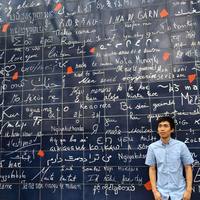Saw Tun Lin (Lynn)
University of Yangon, Archaeology, Faculty Member
People firstly used potteries to keep water and to store surplus food for more than thousand of years. Sun-dried pots, although they are baked up to about 1,150 Celsius, are still porous. So the only way to prevent porosity is to glaze... more
People firstly used potteries to keep water and to store surplus food for more than thousand of years. Sun-dried pots, although they are baked up to about 1,150 Celsius, are still porous. So the only way to prevent porosity is to glaze them. And also glazing is required for preserving fruits or storing oil. Later people tried to decorate monuments and religious edifices with glaze. Glaze has been used in various purposes. It is not certain when making of
glazed work was practiced in Myanmar. It is assumed on the present evidences that glaze started to use abundantly in Bagan period the 10th to 13th century AD. It is found that the glaze plaques and glazed decorative objects in Bagan temples and stupas show the great
workmanship of the then people. Later Martaban jars, the most famous glazed ceramics in the history of Myanmar, have been well known because of worldwide trade during the 14th to 18th century AD. People still use glazed wares and glazed decorative objects and there are some manufacturing sites which still produce glazed domestic wares and other objects in Myanmar. The purpose of using glaze has been changed one period from another. This paper highlights the changing of forms and styles of glazed ceramics and glazed decorative art to interpret the social, economic and cultural life of Myanmar.
glazed work was practiced in Myanmar. It is assumed on the present evidences that glaze started to use abundantly in Bagan period the 10th to 13th century AD. It is found that the glaze plaques and glazed decorative objects in Bagan temples and stupas show the great
workmanship of the then people. Later Martaban jars, the most famous glazed ceramics in the history of Myanmar, have been well known because of worldwide trade during the 14th to 18th century AD. People still use glazed wares and glazed decorative objects and there are some manufacturing sites which still produce glazed domestic wares and other objects in Myanmar. The purpose of using glaze has been changed one period from another. This paper highlights the changing of forms and styles of glazed ceramics and glazed decorative art to interpret the social, economic and cultural life of Myanmar.
Research Interests:
Decorative objects such as glazed terracotta plaques glazed floor tiles and glazed sandstone discs are crucial role in art and architecture of Bagan period. Only 27 monuments out of more than two thousand religious monuments in Bagan are... more
Decorative objects such as glazed terracotta plaques glazed floor tiles and glazed sandstone discs are crucial role in art and architecture of Bagan period. Only 27 monuments out of more than two thousand religious monuments in Bagan are decorated with glazed plaque, fittings and tiles. And 7 kilns that are potential for producing glazed objects decorated at Bagan’s monuments have been in question for industry sites for many years. So it is also a question that when was the earliest use of glaze in Bagan, and why was the green lead glaze used abundantly. While the people of Bagan were familiar with glazed decorative objects, they did not copiously use present the glazing technology as domestic objects on present evidences. This paper states that the surviving structures with glazed decorative objects, and how crucial role of the glazed objects are part of the architectural assemblage of the Bagan period.
Research Interests:
Surāmeraya, to abstain from fermented drink, is one of the five percepts, the basic code conduct practiced by upāsaka and upāsikā (lay followers) of Buddhism. Alcohol consumption had existed long before the tradition of drinking Siy... more
Surāmeraya, to abstain from fermented drink, is one of the five percepts, the basic code conduct practiced by upāsaka and upāsikā (lay followers) of Buddhism. Alcohol consumption had existed long before the tradition of drinking Siy (fermented) and eating meat became a documented social practice in the 13 th century. In some stone inscriptions of the later Bagan period, the celebration of drinking Siy (fermented drink) and eating meat after successfully conducting a meritorious deed, for example, donating land to a monastery was shared by both the donors and the monks. Nowadays drinking alcoholic beverage by a monk is unacceptable from the point of view of the code of conduct for Buddhist monks. Moreover, celebrating with fermented drink or alcohol after the Buddhist meritorious deed is unusual for the layman. This custom was likely influenced by the indigenous practice of worshipping Nat with alcohol and meat. However, the culture of drinking Siy appears to have been prominent in the Bagan period. It is proposed that this was a common occurrence as the name of a person who did not drink and chew betel nuts was exceptionally mentioned in inscriptions. This drinking practice seems to stop when the Buddhist codes of conduct were stronger again in the 16 th century with the king's support, and it was substituted with the eating of pickled tea (la phet).
